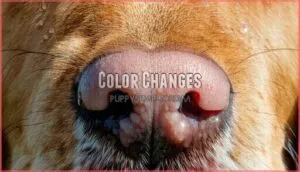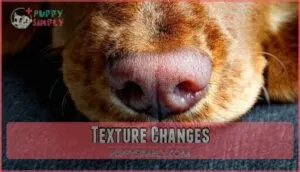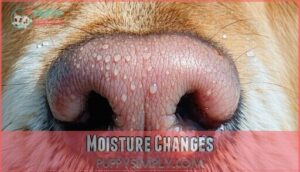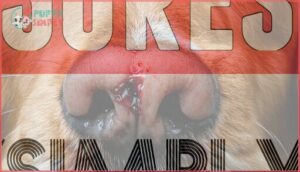This site is supported by our readers. We may earn a commission, at no cost to you, if you purchase through links.
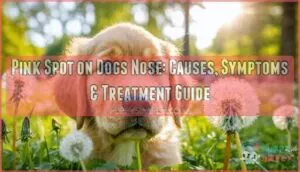
Don’t panic—this affects nearly half of certain breeds and occurs when the enzyme producing melanin becomes less active during colder months or due to genetics.
Your dog won’t feel any discomfort, and it’s completely normal, however, you’ll want to distinguish between regular pigment loss and other issues like allergies or skin conditions that might need attention.
While "snow nose" doesn’t require treatment, understanding when to worry versus when to relax can save you stress and guarantee your furry friend stays healthy.
Table Of Contents
- Key Takeaways
- What is Snow Nose?
- What Causes Snow Nose?
- What Are The Symptoms of Snow Nose?
- Are There Any Treatments for Snow Nose?
- Which Breeds Are More Likely to Get Snow Nose?
- Frequently Asked Questions (FAQs)
- What colour noses can dogs have?
- Can dogs with pink noses compete in the show ring?
- Do dogs with pink noses need sun cream?
- What do pink spots on a dog’s nose mean?
- What is the small pink growth on my dogs snout?
- What does lupus look like on a dog’s nose?
- Why does my dog have a pink spot?
- Is snow nose permanent?
- Are there any health risks associated with snow nose?
- Does the color of a dog’s nose affect their health?
- Conclusion
Key Takeaways
- That pink spot is likely "snow nose" – a harmless condition where your dog’s black nose pigment fades to pink during colder months, affecting nearly half of certain breeds without causing any discomfort.
- You don’t need to treat it – snow nose is purely cosmetic and typically reverses naturally when warmer weather returns, as the temperature-sensitive enzyme responsible for pigment production becomes active again.
- Watch for concerning symptoms – while snow nose itself is harmless, you should see a vet if you notice sores, crusting, bleeding, or sudden texture changes that could indicate allergies, infections, or more serious conditions.
- Protect that pink nose from sun damage – since lighter noses lack protective melanin, you’ll need to apply dog-safe sunscreen during outdoor activities to prevent painful sunburns and potential skin cancer.
What is Snow Nose?
Snow nose, also called winter nose or seasonal hypopigmentation, occurs when your dog’s nose lightens from black or brown to pink during colder months.
Snow nose turns your pup’s dark nose pink each winter—it’s completely harmless and naturally reverses when spring arrives.
This reversible condition affects many dogs due to reduced tyrosinase activity—the enzyme responsible for melanin production.
Cold weather basically puts this pigment-making process on pause, causing temporary color changes.
Don’t worry though; this hypopigmentation isn’t harmful and typically reverses when temperatures warm up, restoring your pup’s original nose color naturally, which is a result of melanin production.
What Causes Snow Nose?
While experts haven’t pinpointed the exact cause of snow nose, several factors likely work together to create this winter phenomenon.
The leading theory involves tyrosinase breakdown – an enzyme responsible for melanin production that becomes less active in cold temperatures. This temperature sensitivity explains why your dog’s nose lightens during winter months.
Here’s what contributes to this reversible hypopigmentation:
- Genetic predisposition – Some breeds are simply wired for winter nose changes
- Cold weather exposure – Lower temperatures trigger the enzyme disruption
- Reduced sunlight – Less UV exposure affects natural pigment maintenance
Changes in pigmentation can indicate an unhealthy dog nose.
What Are The Symptoms of Snow Nose?
You’ll notice snow nose primarily through visible changes in your dog’s nose color, which typically shifts from black or dark brown to pink or lighter shades during colder months.
The condition may also cause subtle changes in nose texture, moisture levels, and in some cases, minor irritation or sores around the affected area.
Color Changes
When your dog develops snow nose, you’ll notice their once-dark nose gradually shifts to lighter shades.
When winter arrives, your pup’s dark nose transforms into a charming pink masterpiece that’ll have you doing double-takes.
This dog nose color change typically appears as pink or light brown patches, sometimes creating a stripe down the center.
The dog nose discoloration from pigment loss doesn’t happen overnight—it’s usually a slow transformation.
While some dogs experience complete nose lightening, others show partial changes that create a mottled appearance, making this dog nose turning pink condition quite distinctive, with a distinctive look.
Texture Changes
When examining your dog’s nose for snow nose, the texture typically remains unchanged from its normal feel.
Here’s what to expect:
- No nose crusting or roughness develops during pigment changes
- Dryness levels stay consistent without cracking or scar tissue formation
- Bump severity remains minimal with no ulcer formation affecting sleekness
Your dog’s nose texture should feel the same despite color variations, maintaining its natural smoothness without developing concerning textural abnormalities.
Moisture Changes
When checking your dog’s nose for snow nose, you’ll be relieved to know that moisture levels remain unchanged.
Unlike other nasal conditions that cause nasal dryness, excessive tearing, crusty discharge, nasal congestion, or breathing difficulty, snow nose doesn’t affect your pup’s normal dampness.
The nose stays pleasantly moist without any concerning discharge or uncomfortable dryness that’d worry you.
An unhealthy dog nose can sometimes signal dehydration.
Sores
Unlike typical snow nose cases, sores on your dog’s nose signal potential health concerns that need immediate attention.
Snow nose itself doesn’t cause sores, crusting, or scaling—just harmless color changes.
However, infected sores may develop from bacterial contamination, while allergy sores result from contact dermatitis or food sensitivities.
Trauma sores occur after dog nose injuries from scratching or accidents, often accompanied by dog nose bleeding.
Autoimmune sores appear with conditions like lupus, creating ulcerated areas.
Most concerning are cancerous sores, which may indicate nasal tumors.
Watch for dog nose crusting, dog nose pus, or persistent bleeding—these symptoms require veterinary evaluation to rule out serious conditions beyond simple pigment loss, including nasal tumors and autoimmune issues.
Are There Any Treatments for Snow Nose?
Unfortunately, there’s no cure for snow nose, but you can protect your dog’s changing pigmentation with these supportive measures:
- Sunscreen Options – Apply dog-safe sunscreen to prevent further melanin breakdown and protect sensitive pink areas from UV damage.
- Vitamin Supplements – Consider vitamin E supplements, which may slow pigmentation loss, though results aren’t guaranteed.
- Cold Weather Gear – Use nose balms during winter months when dog nose pigmentation loss typically worsens.
- Alternative Therapies – Switch to stainless steel bowls instead of plastic, as chemicals can sometimes affect dog nose treatment outcomes.
Many owners also use sunscreen for dog’s nose to protect from sun damage.
Which Breeds Are More Likely to Get Snow Nose?
Certain dog breeds show genetic predisposition to snow nose due to breed variations and coat color genetics.
Siberian Huskies, Golden Retrievers, and Labrador Retrievers commonly develop this dog nose pigmentation change.
Geographic location influences severity, with colder climates triggering more cases.
Bernese Mountain Dogs also experience breed-specific concerns related to pigment loss.
Unlike Collie Nose, snow nose affects breed popularity minimally since it’s purely cosmetic.
These breeds historically worked in cold environments, suggesting hereditary factors contribute to seasonal pigmentation changes in their noses.
Frequently Asked Questions (FAQs)
What colour noses can dogs have?
Dogs can have black, brown, liver (purple-brown), pink, or mixed-colored noses.
Your pup’s nose color depends on genetics, breed, age, and pigmentation.
Some breeds naturally sport pink noses, while others develop them seasonally.
Can dogs with pink noses compete in the show ring?
Like a perfectly painted masterpiece with an unexpected brushstroke, your dog’s pink nose won’t automatically disqualify them from competition.
However, breed standards often favor darker noses, potentially affecting placement in conformation shows.
Do dogs with pink noses need sun cream?
Yes, you’ll need dog-safe sunscreen for your pink-nosed pup. Their lack of protective melanin makes them vulnerable to painful sunburns and skin cancer during extended outdoor adventures, especially in summer.
What do pink spots on a dog’s nose mean?
Pink spots on your dog’s nose typically indicate harmless pigment loss from aging, cold weather, or minor scratches.
However, raised bumps, bleeding, or sudden changes warrant immediate veterinary attention to rule out serious conditions.
What is the small pink growth on my dogs snout?
A small pink growth on your dog’s snout could be a nasal polyp, benign tumor, or irritated tissue from scratching.
Schedule a vet visit immediately, as these growths require professional evaluation to rule out serious conditions.
What does lupus look like on a dog’s nose?
Lupus on your dog’s nose appears as depigmented pink patches where dark pigment has disappeared, often accompanied by bleeding ulcers, crusty sores, and inflamed areas that worsen with sun exposure.
Why does my dog have a pink spot?
Several factors can cause that pink spot on your dog’s nose.
Most commonly, it’s harmless pigment loss from aging, cold weather, minor scratches, or genetics—but watch for changes in size or texture.
Is snow nose permanent?
Like a chameleon’s color-changing act, snow nose isn’t a permanent transformation.
Your dog’s nose will likely darken again when warmer weather returns, as the temperature-sensitive enzyme tyrosinase resumes normal pigment production.
Are there any health risks associated with snow nose?
Snow nose doesn’t pose serious health risks since it’s purely cosmetic. However, your dog’s lighter nose becomes more vulnerable to sunburn, so you’ll need dog-safe sunscreen during sunny outdoor adventures.
Does the color of a dog’s nose affect their health?
Your dog’s nose color doesn’t directly impact their health.
But pink noses lack protective melanin, making them more vulnerable to sunburn and potential skin cancer from UV exposure than darker noses.
Conclusion
Ironically, that alarming pink spot on dogs nose that sent you searching the internet is probably the most harmless thing you’ll worry about all week.
Snow nose affects countless dogs without causing discomfort or health issues. You can’t prevent it, and you don’t need to treat it.
Simply monitor for unusual symptoms like sores or irritation that might indicate other conditions.
Your dog’s changing nose color is just another quirky trait that makes them uniquely yours, and it’s something to watch for unusual symptoms.


